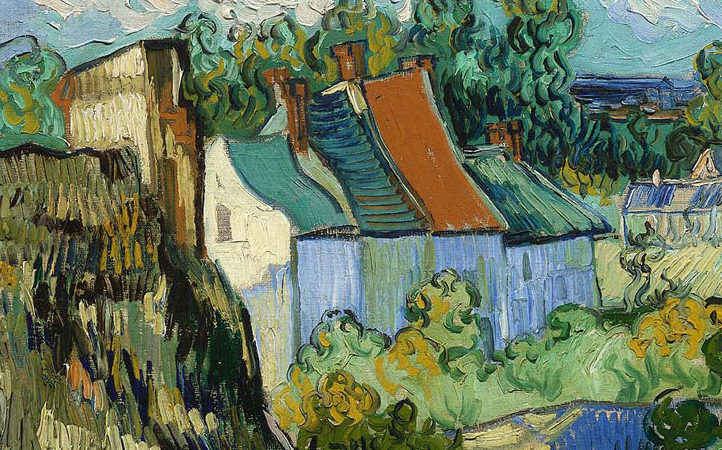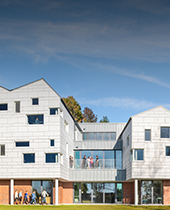“Museum Epiphanies”
Now in April, 2014, we are confident that we are living in a modern, innovative, and enterprising age. However, the term “Modernism” was first coined in France in the 1840s. Baudelaire’s “Heroism of Modern Life” was essentially a rallying cry to a generation of artists and writers whose lives spanned a period of unprecedented change in the world order. The Heroic/Romantic age came to a close. Enlightenment ideals, and with them the promises of revolution, failed to materialize. Authoritarianism began to gain ground. Populations shifted from the country to the cities in a period of unparalleled urbanization. These changes ushered in the 20th century with its technological and scientific innovations, socio-political struggles – Colonialism, World War, etc. – and the shift in power and influence from the Old to the New World.
Such is the fascinating backdrop to this semester’s Upper School Art History elective – “Masterworks of Art History: The Modern World.” The course explores the history of predominantly Western art from 1848’s Paris, the epicenter of artistic creation and influence, to 1950’s New York, by then the new “mecca” of the art world. We delve into the environments that inspired the artists, explore their works as aesthetic and as a vehicle for social, political, philosophical, and personal expression. We also will attempt to explore the indebtedness of modern art to the past (Picasso to Goya, for example) and study the enormous influence of artistic ideals and principles from the Far East, North and Sub-Saharan Africa, and Polynesia.
In early April, we did ‘field work’ at the Museum of Fine Arts in Boston, whose collection and current exhibit on Impressionism dove-tailed perfectly with the focus of our class. We were graciously met by Katherine Getchell (Waynflete ’88), who gave us a private tour of the “Boston Loves Impressionism” exhibition and invited us down into the storage area – a veritable “Aladdin’s Cave!” Below are the impressions of two members of the class, Henry Johannen (sophomore) and Ellen Langford (junior) as they reflected on their experience at the MFA:
The MFA trip was conducive to the realization that art history is an essential field of study for those wishing to gain a better understanding of the evolution of western culture and the human condition. No amount of study or books could impress upon us the allure, grandeur, and majesty of seeing the original paintings in person. For me this was most apparent when I saw Van Gogh’s “Houses at Auvers” which had been my favorite painting; the intensity of the brushwork conveyed a furious passion that hadn’t been visible before. Seeing the paintings in person was a powerful experience, which I think everybody should get the chance to have. Henry Johannen
What was extraordinary and exciting about my experience at the MFA in Boston earlier this month was the impact of seeing the art we have been studying “in the flesh” versus seeing it digitally on a screen. The hues, shades, and tones were ‘true,’ fully expressing the artist’s original intention: evoking shifting moods through color, line, and brushstroke. I was excited to see Monet’s layering of paint, his building up of colour that produced such extraordinary effects. I was struck by the dimensionality created Van Gogh’s heavy impasto and vigorous brush stroke; we had discussed his “House at Auvers” in class, but I had not expected to feel so close to the artist as I appreciated the power of his painterly process, a power that was lost, flattened, by the seeing the work through electronic media.
I find that I am drawn to make very personal connections with works of art, and this happens when I am fascinated by the personality and life of the artists. I have grown to love Van Gogh, having read his letters about his artistic aspirations; I would have loved to be present listening to him talk about his art, witnessing his frantic yet brilliant compositions appearing before my eyes. Leaving Van Gogh’s works, I was determined to find JMW Turner’s “Slave Ship,” a work I had studied last semester. The power of his colour and brushstroke, and the specific and cruel details of the limbs and shackles of the slaves thrown overboard burst out of the work with a force and clarity that I had not been able to appreciate fully in class. Looking at the mounding paint, I could imagine seeing Turner working the paint with his fingers. Seeing the “Slave Ship” in real time allowed me to feel the full emotional force of this incredible work.
Having become so familiar, or so I thought, with the poster of Mary Cassatt’s “In the Loge” that hangs in Breda White’s classroom, I was delighted to discover that my love of the work increased even more by seeing it in the Museum. I focused deeply on the details of the work, especially to the protruding vein in the inside of her wrist. I was blown away by Caillebotte’s “Man at his Bath.” The scale of the work was so much larger than I had anticipated. Viewing the piece at eye level, I now appreciate why this work was so scandalously modern.
As I made my way through the different exhibitions, I found myself evaluating the frames that surrounded the works; some were so overly ornate that they overwhelmed the piece and distracted from the painting. Did the artist ask for that frame or did the Museum make that call?
I loved the design and layout of the Museum. Every single section felt different, created a different atmosphere; I am still convinced that the French Impressionist section had a distinctly different smell, another assault on my senses. I loved being able to wander through the Museum’s labyrinth of corridors, following them to discover incredible works of art. If pressed for time, however, the labyrinth design, though cool, could easily become very maddening! Our private visit to the MFA vaults was incredible, though I must say that I thought the vault was a little sad – all those great works that should be appreciated were “in waiting” in the basement. Those Degas pastels? I would love to see them in the galleries!
Visiting the MFA with my Masterworks class was a wonderful personal experience and a shared experience. Viewing works of art with my classmates was a positive shared, yet differentiated experience; I loved how my small group saw the same things, yet reacted so differently to them. I already am looking forward to a return visit to the MFA, which with any luck will be paired with a visit to Isabella Stewart Gardner Museum. Ellen Langford
The work above, which hangs in the Museum of Fine Arts in Boston, is a very recent realist piece and third in a series inspired by the interaction between museum visitor and the art. The artist, Warren Prosperi, said of his work, ““The Epiphany series tries to take advantage of the special quality of the Museum environment, where works of art and the visitors produce a powerful dialogue: between creative minds of the past and both sensitive and distracted viewers of the present. The Epiphany title refers to the sometimes transporting insights which can occur during that dialogue.”







